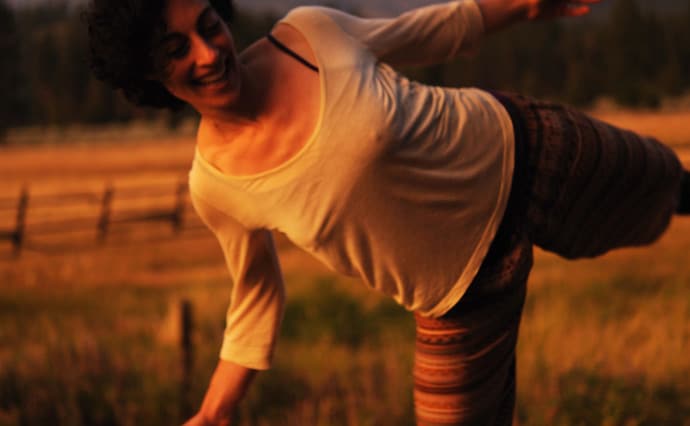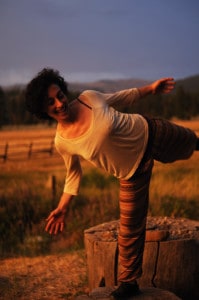5 Reasons NOT to Straighten Your Spine

- They claim to have bad posture, and therefore
- They try to straighten themselves up throughout the day
The straightening up doesn’t seem to improve their alignment in the long run, and it certainly doesn’t do much for easing their pain. And yet it also doesn’t always occur to them that trying to “fix” their posture by “straightening up” is actually contributing to the discomfort and making it a “fixture” of their lives.
Here are five good reasons NOT to straighten your spine, especially if you’re looking to improve your alignment and find more ease and release in your body.
1. Your Spine is Curved to Begin With
Your spine is curved, not straight, and that’s a very good thing. The four curves of your spine – sacral, lumbar, thoracic and cervical – are precisely what makes it so strong and able to support your weight in an upright position.
If you’ve ever been to any kind of fitness class, chances are the teacher has used an image at some point to help you visualize the movement you’re going for. That’s because your body responds well to images, especially when they’re relevant and tangible to its experience.
But since the image of a straight spine has nothing to do with the reality of your structure and isn’t a tangible or even desirable goal by any stretch, you’re better off without it.
Your time and effort are much better spent getting to know the particular curves of your spine. This means cultivating mindfulness of your own body, and accessing imagery that is true to your experience in the moment. This kind of imagery is much more effective when it comes to helping you sense the placement and possibilities of your alignment.
And if you’re looking for realistic solutions, keep this in mind:
Alignment and support aren’t actually about position – they’re about relationship.
This is as true for your body as it is for your heart. And mind.
When it comes to your spine, as you begin to literally “see” your curves, you also begin to learn how to adjust the relationship of one curve to another so that your weight is better supported.
2. Straighten Up? What about Down?
Our Western culture has a fixation with reaching up – we don’t even realize the extent to which this spiritual concept ends up infiltrating the way we move and carry ourselves throughout the day.
But anyone with any understanding of physics – scientists, building contractors and dancers alike – will assure you that there is no such thing as “up” without “down”.
You can reach up all you want, but getting more length in your spine requires grounding.
Unfortunately, when we command ourselves to straighten up we tend to completely forget about reaching down. And so the musculature of your upper body – i.e. your neck and shoulders – ends up having to carry much more mass over long periods of time than it’s really built for.
No wonder your neck and shoulders are sore – they’ve literally been “weight lifting” all day!
Next time you feel the urge to straighten up, just take a quick moment to see if there’s space for your hips to relax down and if you can feel the weight of your body dropping through your feet. Taking that extra weight and sending it down with gravity where it belongs will do at least half the work of releasing your spine and giving it more space to lengthen.
3. You Move in Circles and Spirals, Not Lines
Here’s another misleading image that’s constantly being thrown at you.
As with trying to “straighten” your spine, you’re told reach your arms out and extend your legs as if they were linear masses on linear tracks, and the more you force the alignment, the more aware you become of how tight you are.
When in fact your movement relies on round joints! And the way to release your joints, especially the joints of your spine, is NOT to lock them in a straight line, but to make sure they have plenty of space for round, juicy movement.
What’s more is that there isn’t a single bone in your body that resembles straight. In fact, if you look at the bony structure of both your lower arms and lower legs, you’ll notice that the bones – radius and ulna in your arms and tibia and fibula in your legs – have a spiral-like movement around each other.
The way you walk is also a spiral action, a double helix resembling the very structure of your DNA. Notice when you’re walking that as your right leg strides forward it’s your left arm that’s swinging forward – this is one simple way to tune in to the spiral movement that your spine conducts throughout the day.
Yoga, Qi Gong and other ancient movement modalities have a lot to say on this subject, but it’s enough to observe your walking to begin to sense it for yourself.
4. Fixating Leads to Pain
Another great reason NOT to fix your alignment by straightening up is that alignment is never fixed. You live in a moving universe, on a moving planet, in a body that’s made up of trillions of moving particles. Good luck fixing anything into place, ever.
Fixing and fixating (on posture or anything else for that matter) are bound to lead to pain because they involve holding, which requires an immense amount of energy.
The joints of your spine are built for an incredible amount of movement. We’ve already talked about up and down, but sliding your right arm down your right leg will quickly reveal your capacity for movement from side to side, craning to look up or leaning forward to pick something from the floor will give you a taste of forward and back, and turning to look at someone behind you is a great way to experience movement around your central axis.
The way to less pain and more ease in your spine is more movement.
Instead of trying to hold yourself upright or in any other position, be greedy for movement. If you feel yourself slouching or getting tight, get up and walk around. Follow stretches and exercises you’ve learned or invent movements yourself which open up your awareness to all the possibilities of movement you haven’t been exploring while sitting at a desk and walking down straight, narrow hallways.
If you’re not sure what stretches and exercises to do and don’t feel like inventing them on your own, consider coming to work with someone like me. I help people create personalized toolkits to serve both their everyday and long-term needs, and my upcoming Semi-Private Group Session – RELAXED Strength & POWERFUL Alignment – is all about learning how to strengthen, lengthen and release your spine.
5. Your Breath – Not Your Muscles or Your Mind – is What Holds You Aloft
Your breathing is the underlying movement that keeps you going: it’s happening all the time (though maybe not as fully and elastically as it could be if you’ve been in front of a screen or sitting at a table for hours) and giving it a little bit of attention is likely to give you a lot more reach and relief than sucking-in in order to straighten up.
Since we’ve already established that more movement is more better and that your breath is at the root of your movement, it naturally follows that more breath is best of all.
Unfortunately we spend large parts of our day breathing very little. And being out of practice, we’re surprised (and maybe even put upon) at the suggestion that this is a part of our lives that requires diligent focus and intention. It’s not until we’re exasperated with pain and forced to do nothing but breathe that we begin to truly appreciate the importance of constant practice and awareness.
For a technical understanding of why open and plentiful breath is so important to your back, consider that your primary muscle of inhalation – the diaphragm – is located right in the middle of your torso, spanning your upper lumbar vertebrae to your mid-thoracic. If your diaphragm isn’t doing a lot of moving, neither is your spine and pain is likely to follow.
With the movement of the diaphragm and the filling and emptying of your lungs come changes of pressure in your torso in general and spine in particular. It’s these changes in pressure that are keeping you aloft.
As pressure builds on an inhale, you expand and create a lightening of the load. And every exhale presents an opportunity to release pent up pressure as well as weight, and experience the amazing support of gravity and the ground below you.
If the movement of your vertebrae and muscles are the mechanics of alignment, the breath is the energetics behind it. Which is why if you want an alignment that supports plentiful and vital energy tuning into your breath is the key.
Interested in learning more about the mechanics and energetics of a strong and supple spine?
Then make sure to check out the upcoming 90-Day Semi-Private Group Session:
RELAXED Strength & POWERFUL Alignment
You’ll spend 13 consecutive weeks in a small, intimate group of five or less learning how to access more strength and alignment by understanding how you mobilize, stabilize and release the spine.
There are only 2 spots remaining, so act quickly!
If you prefer to create your own personal toolkit of exercises, make sure to schedule a complimentary consultation. I only have space for 3 of these a week, so book now.
Use the form below to contact me ASAP!
Do you want to use this article on your ezine/blog/site?
You’re welcome to share this article, as long as you include this complete blurb with it:
“This is an article from Ophra Wolf, Embodied Wellness Coach and owner of Force & Flow Integrated Bodywork, where she helps high-performers and brilliant visionaries making significant shifts and contributions to their personal, professional and global environments to align with their highest potential. You can subscribe to her fr.ee newsletter and learn more about her unique approach at www.forceandflow.com”
Error: Contact form not found.


Share Your Thoughts
You must be logged in to post a comment.